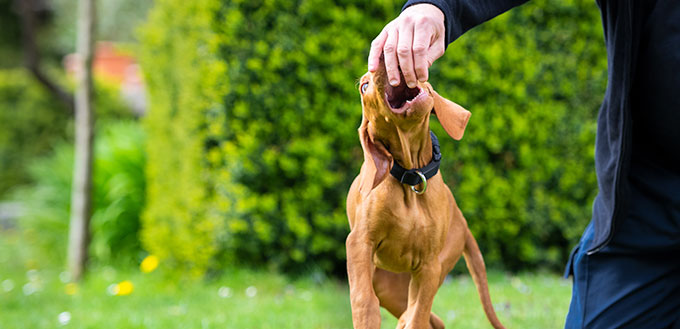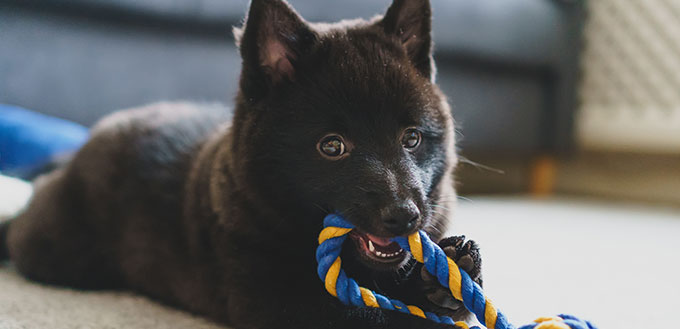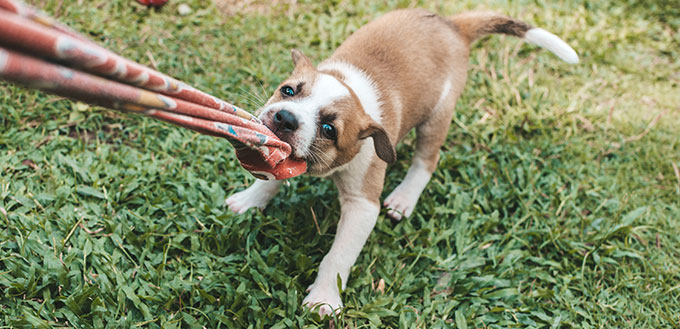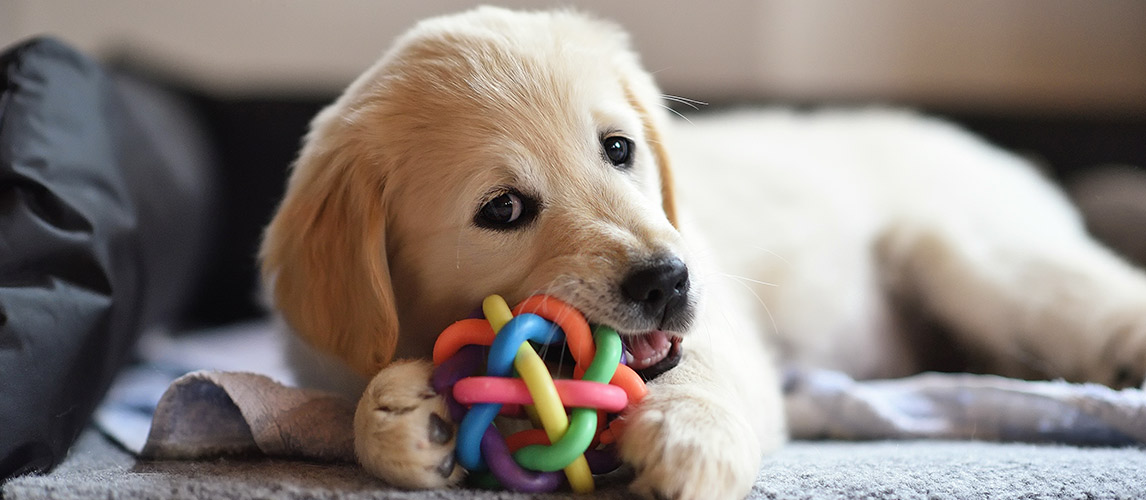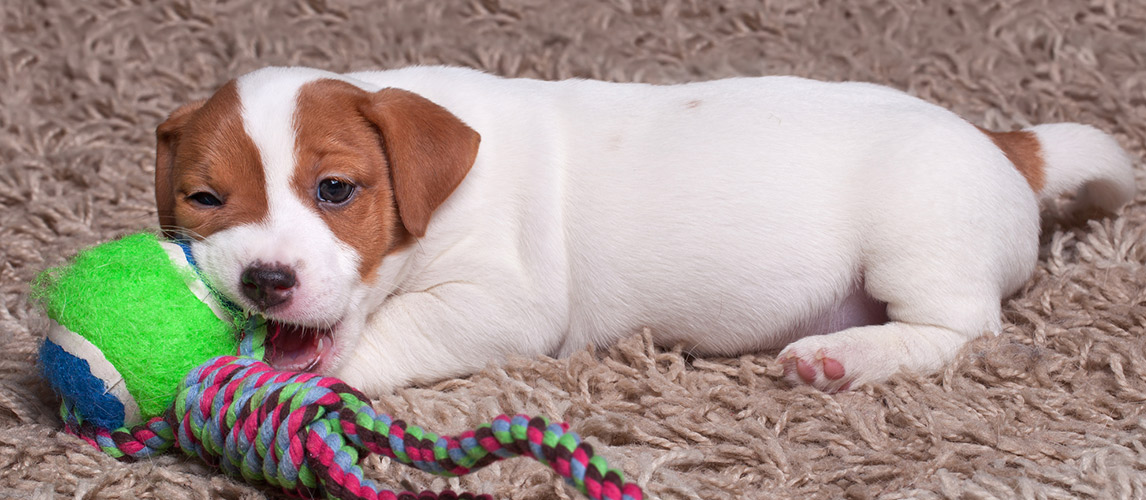What are the best training tips for a puppy who’s teething? When do puppy teeth fall out? When should I be worried about my dog’s gums and teeth? Every dog owner has found themselves asking these questions sooner or later – and we’re here to help. Whether you’re dealing with a puppy who is in the middle of teething, or wondering what signs to be looking out for, we’re here with all the answers you need to look after your puppy and upcoming adult teeth, with puppy teething survival tips and guide.
When Do Puppies Start Teething
Depending on the age you get your puppy from, you may be dealing with puppy teething of the deciduous teething phase (baby teeth with no root) or their adult teeth (permanent teeth which have a root). Both of these can have different effects on your puppy, so the person who cares for them should be clued up on both types.
Deciduous Teeth
Just like humans, puppies have two sets of teeth. The first set is called the deciduous teeth and you’ll find that these should erupt (break through the skin of the gums) at around three weeks. If you’re a puppy breeder, you might find that your pup and their littermates will start mouthing at around this stage of growing up.
This process can be the most difficult phase, because your puppy is unlikely to have the capacity to understand your training techniques. However, there are still some things you can do to help with the discomfort and pain of puppy teething. There are usually 28 deciduous teeth, so do keep an eye on the number of puppy teeth popping through at this stage.
Adult Teeth
Adult teeth replace the milk teeth of your pup, and then some. In total, there should be 42 permanent teeth coming through during this phase. Again, if you breed puppies, you may find yourself inundated with puppy teeth at this point in the process. For those who have brought their dogs home, be prepared for a couple of changes in your dog during the teething phase. We’ll give you more information on what to expect, below.
Don’t worry too much if you notice your dogs’ teeth are missing from their gums, but you haven’t spotted any around the house. Puppy teeth are often swallowed as they come loose while eating, to no ill effect. Sometimes, you may not know at all, except for finding some blood spots on your dog toys. By around 3-4 months, your pup is likely to have begun teething, and dogs that are around 6-7 months old should have their full set of adult teeth.
How Long Do Puppies Teeth
For very young dogs, puppy teething begins at around 3 weeks and it usually takes around three weeks for your dog to have a full set of puppy teeth. So, the human family member is likely to spot some behavior changes at around this time, such as a tendency to mouth toys and any unfortunate person who happens to be playing with them. Consider yourself warned that puppy teeth are extremely sharp and prone to catching on anything and everything!
Adult teeth come in at around 3 months and may take up to 4 months to fully erupt. It’s around this time that pet parents will spot bite marks in everything from chew toys to furniture. The good news is that, during this phase, your pup is much more likely to respond to training steps. Luckily, we’ll be giving you all the training information you need, below.
When to See a Veterinarian About Puppy Teething Problems
Most of the signs and symptoms of puppy teething are completely normal and can be helped through the use of patience and persistence in training. A puppy who bites, mouths and chews a lot is definitely a sign of teething – but the process can be helped along with some strategic play with toys, some handy products and crate training. You might also notice that your puppy’s breath is not so pleasant. Again, this is completely normal – even if the smell isn’t so nice and their gnawing and chewing leaves the odor all over the house.
The biggest concern when it comes to teething (aside from having to buy new furniture and covering up furniture legs) is persistent teeth. This is when the puppy teeth stick around, even after the adult teeth have broken through. The stubbornness of the milk teeth can sometimes cause the adult tooth to break through the gums at an awkward angle. The result of this can be an abnormal bite, crowding and sometimes a gum infection.
This is more common in some dog breeds than others. So those dog breeds with brachycephalic heads (dogs with a short nose and/or muzzle) are prone to persistent teeth. While this may not always have a major effect on the life of your pup, it can sometimes cause problems and will require a visit to the vet. This is usually just to get the baby teeth removed, so that the adult teeth can grow normally.
While having these removed may not make a major difference to the behavior of the dog who will still be teething, it can help prevent further complications. Sometimes, a quick visit to the vet can help prevent the daily treat, dinner and debris from catching between the problematic tooth placement. Thus, you can ensure that your pup doesn’t suffer from tartar deposits, gingivitis, and ultimately periodontitis – simply by keeping an eye on their mouth and checking that the teething phase is proceeding smoothly.
What To Do For Teething Puppies
One of the best things you can do to help with the teething phase is to puppy-proof your home. Puppies that are teething love to get into anything and everything they can get their mouth on. No matter the object, all items that are in the way of your pup are prone to receiving bite marks!
For this reason, the biggest help we can offer pet parents is to hide belongings that you don’t want to be chewed. This includes any permanent object, such as the carpet, which you may find pulled up and torn apart if they’re loose. Similarly, shoes, the post, or something that simply looks chewable should be removed from the sightline of your pup, as these are all seen as prime pain-relieving resources.
There are also a couple of products that have been designed specifically to help keep your pup away from the carpet, off your hands and focused on their toy. One such product is a gel that you can rub on anything you don’t want chewed. While we can’t help you get to your post before your puppy, it will help them understand that some furniture simply doesn’t taste nice when it’s chewed.
What To Give A Teething Puppy
Now that you know what NOT to give a puppy that is teething, it’s time to discuss what they CAN have. Do remember that any items you pass to your pup should be age-appropriate. As an example, some Kong toys can be too tough for very young dogs, and should be avoided until they have the jaw strength suited to this kind of toy. Teething relief for puppies is remarkably easy to find – once you know what your pup loves. These are just some of the alternatives to giving a treat more times than you may like!
Cold Chews
Chew toys are some of the best options to keep your hand free of any nipping. Bully sticks and yak’s milk chews are great choices on their own, and these products even help to keep your dog stimulated physically and mentally. However, popping them in the freezer before handing them over to your pup can provide additional relief from the mouth pain that comes with teething.
For very young puppies, ice cubes can be an absolute lifesaver. Dogs aren’t as inclined to chew on these, but licking cold ice cubes can provide relief and may stop your pup from chewing on items that may harm them in the long run. Carrots can also be frozen and work brilliantly as a treat for dogs, without worrying about the nutrition content of a dog treat.
Another good idea for a younger pup can also be to freeze some dog food in ice cube trays and let them focus their attention on those. Chicken broth is always a winner in this department – for both adult and younger dogs! Simply boil some chicken stock with water and let it cool, before placing these in the freezer.
You may also find that your dog toy has been created to help with teething problems. One such toy is the kong, which will often come in different strengths, sizes and gaps. The gaps in the toy can be filled with water – though you may have to use some cling film to help, here – which can then be frozen and given to your dog. If that’s too fiddly, filling them with some peanut butter or cheese can work wonders. You may even be able to combine these with carrots. Simply blend the carrots into a puree and use this in the toy.
As much as you may not want your hand to consistently be the source of your pup’s chewing, we generally would not recommend bones. If you do want to give your pup bones, be sure that they are raw and your pup cannot fit the whole thing into their mouth. Avoid larger marrow bones and those which have been sawn in half or sideways, as these are more likely to splinter.
Distractions
Another great option to keep their attention, reward good behavior and prevent bad habits is to use dog toys as a distraction. Just be sure to keep your hands out of the way – ideally at the end of the toy that is farthest from their mouths, as puppies have a tendency to be a little clumsy with their nipping.
For this reason, rope toys are some of the best options for helping both your training steps and as a distraction from chewing the furniture. Rope toys also have the added benefit of being able to withstand extensive chewing. Just be aware that you may find some string in your pup’s poop if they’re left along with their toy for too long! For older, tougher puppies, rubber toys can also do a great job of resisting constant chewing behaviors. Finding something that works for your dog can take a little time, but the benefits of having the right toy for the right pup go way beyond the con list!
How To Stop A Puppy From Nipping
While the average pup is unlikely to give you a full-blown bite, it can still be horrible to subject your hands to constant chewing and nipping. On the one hand, you may prefer your hands getting caught up, rather than anything else around you – whether that would be your carpet, post and shoes, or whether that would be a tree when you’re out walking. On the other hand, we understand that going through an endless supply of chew toys isn’t really the answer, either. Instead, we recommend some of the following options:
Puppy Training
Firstly, we would always recommend taking your pup to a puppy class. These can be found the world over and you’ll often find tips from other classmates on what worked for their pup. It also comes with the added benefit of ensuring your puppy and you learn how to communicate with each other and will help you form a closer bond.
Remember that stopping your puppy from nipping is all part of the training process that comes with having a young dog. Do remember that this is something that will pay off in the long run and you may come up with a unique idea that works for you and your pup, that isn’t on this list.
Sources:
- Krista Williams, BSc, DVM, Teeth, Teething and Chewing in Puppies, VCA
- Puppy Teething 101: What to Watch Out For, Vetstreet
Note: The advice provided in this post is intended for informational purposes and does not constitute medical advice regarding pets. For an accurate diagnosis of your pet's condition, please make an appointment with your vet.


